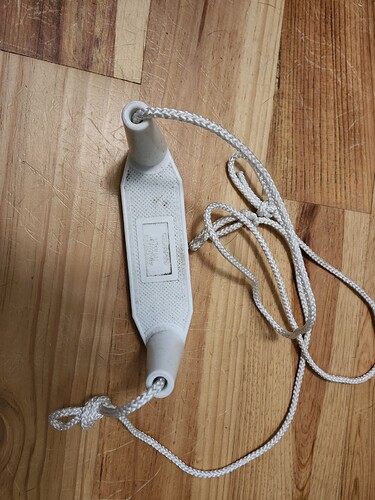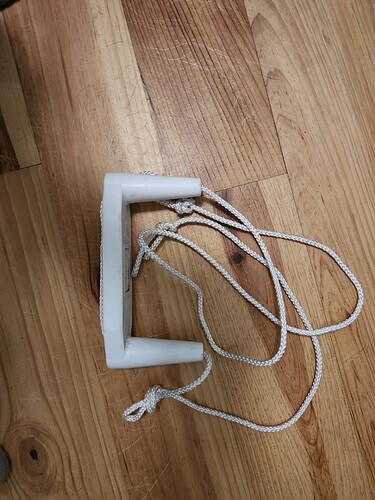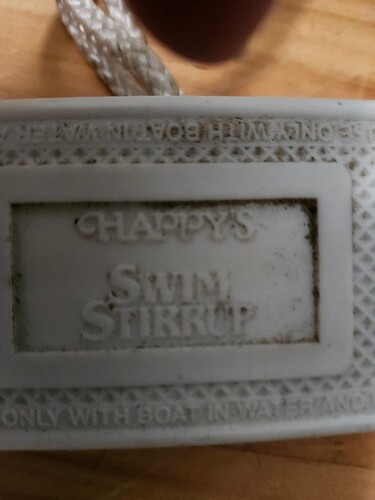My partner and I have a Current Designs Libra XT, using it as a “triple” kayak with our 7-year old child paddling in the center hatch. We are sea kayaking in the Pacific Northwest (Howe Sound, northwest of Vancouver, British Columbia, Canada). We are generally paddling alone (it has seemed hard to find similarly-interested paddling companions), and trying to practice all the recovery/rescue options we may need, even though we at most expect to just paddle between islands when the wind forecast is less than 10 knots or so. We’ve practiced capsize recovery in basically this way Tandem Re-enter and Pump Recovery | Paddling.com, (helping our child back in first). But where we are currently stumped is preparing for if one of us ends up too injured (or tired) to re-enter. We’ve been trying to do a double scoop recovery from this great resource Double Kayak Scoop Rescue/Recovery | Paddling.com. But when I try to pull the kayak back over from the opposite side, it seems that because I am ~130 lb and my partner is ~230 lbs my weight is not enough to right the flooded kayak plus half his body floated into the cockpit. Not enough even with my ~40lb child hanging off of me, or off of the kayak, for extra weight (though we we only tried that once, she is less up for practicing it than we are!). What else could we try for this situation? Can the paddle float help somehow? Anyone have experience similar to this? And any tips in general for our goal to be safe paddling family doing some island hopping?
I can’t say how it could be done if the larger paddler was too injured to help, especially with that much difference in weight.
But if both paddlers can do part of the effort, the easiest way to do it is to place 2 paddle floats on 2 paddles and coordinate a re-entry and roll at the same time. Because the heads of both paddlers go under just before the roll, the easy way to signal is for one paddler to tap 2 times on the hull with the paddle so both know when to start their sweeps. Rolling that way with paddle floats is very easy.
As with an airplane which looses cabin pressure, you can’t help a child if you are helpless, so the child needs to be pulling into the kayak last. It’s not what the child wants most times, but a small child can’t help a large adult so having both adults in the kayak 1st is the only safe way to then help the child.
Another way to proceed maybe as follows;
If the biggest strongest person re-enters 1st that paddler can scull against the direction of pull for the 2nd smallest person making the scramble up onto the deck much easier. When the largest person and the 2nd largest person are in, the 2 of them can help the child. If the child can pull themself into a cockpit it’s best for both larger paddlers to scull. If the child cannot pull themself into the cockpit, then have the smaller of the 2 paddlers help the child and let the strongest one do the support with sculling and off-set body weight.
And if the cockpits are flooded a bailing bucket is much faster then a pump to get the water levels down. I used a collapsible silicone bucket.
Something like this.
when the water is only 2-3 inches deep in the cockpit, THEN get out the bilge bump and take out the rest. But bailing 1/2 to 3/4 gallon per movement of the hands empties the cockpit a LOT faster then using only bilge pumps and the bucket is stored behind the seat on a 3 foot cord.
Some thoughts.
Paddlefloat can be useful to help provide extra balance. If in your rescues you find you are flipping back over (or coming close to flipping over), using a paddlefloat can help.
Never tried the double scoop you talked about, but scoop rescues in general are VERY hard. Harder yet if the person being scooped is larger than the person doing the scoop (as in your case).
Is it injured or tired that you think will cause you to need to go to a scoop rescue? If tired, the next question is if you are dressed for immersion? Spending any time in cold water will quickly tire someone out. The cold will drain energy. Water temps around you are cold - Vancouver Water Temperature | Canada. Wet suit (3mm farmer john is often a minimum) with added layers of polypro, wool, or fleece should be a minimum. Dry suit is better (but are expensive). This will give you more ability to spend time in water before your energy is sapped.
If injured, that is a different story. Worst case, thermal protection (wet suit or dry suit) gives you more time in the water for help to get to you. But of course you need a way to call for help that you can access and use from the water. Cell phone in dry bag that you can work the buttons through, waterproof VHF, personal locator beacon, etc. Not stored safely in hatch, but attached to you.
One tool that could help a tired or partially injured paddler back in is a rescue stirrup (generally would work in conjunction with a paddlefloat). This is a webbing/strap setup that you turn into a ladder rung letting someone step into the rung and lift themselves up onto the kayak. North Water, a BC company, make a good one: Rescue Stirrup – North Water. If you go this route, definitely practice with it to make sure you know how it works and adjust lengths so that it works for your kayak. Even with it set up for your boat, it does take some time to deploy, so if someone can get out of the cold water and in to the kayak without it, they should.
If you haven’t, taking a rescue class in singles can be quite informative toward your double rescue. In many ways it is harder in a single, as you don’t have the second person to balance and the boats are more tippy. Though singles are lower on the water than a double, so you don’t need to get up as high out of water to get back in a single.
Classes specifically for doubles are few and far between, but some places can make a private lesson for you. If you did go this route, you’d would want to find a place that works a fair amount with doubles, so you can find a person to teach that is familiar with the doubles rescues.
Deep Cove Outdoors (https://deepcovekayak.com) has long had a good reputation and I’ve known some high level paddlers (and good folks) who worked there. Jericho Beach Kayak also seems to have some quality folks - https://jerichobeachkayak.com/. Probably other good places in the area too.
For the tired part, and I assume that this simply means muscle failure in the way it occurs with weightlifting - you just can’t pull yourself up with your arms. A stirrup can be very helpful with this. It’s good to practice, because you have to get it to the correct length, and it’s best to figure out how to get and keep your foot in the stirrup while you’re fully able and energetic, so that when it’s actually needed, everyone understands how to make it work. A step on a rope requires a bit of coordination, but it’s not that difficult to gain a knack for it. Some people just use a loop. I picked up this Chappy’s Swim Stirrup years ago as it makes the foot placement easier. But it’s whatever works for you. A stirrup will allow a person to use their legs to hoist themselves up onto the deck instead of just relying on arm strength. It can make a huge difference.
The scoop may be tricky in your situation. First, the able bodied person is going to need to be in the cockpit with the rudder control if the disabled person is unable to perform that part. Directional control from the bow only can be difficult, where it is not difficult from the stern only. So if you have and use a rudder, the able paddler will want to end up in the rudder control cockpit. If you don’t have a rudder, the able paddler will want to be in the stern position. I have tandems that have the rudder control in the bow cockpit, and others in the stern cockpit, so this really can depend upon the kayak.
With a completely disabled partner, things may be tough. I think much like a scoop rescue between two single kayaks where a small person is righting a larger person, you have to get the disabled person scrunched as far forward into the cockpit as possible. Their feet in up to the bulkhead, beyond the footpegs, legs scrunched up as far forward as you can get them. Then all focus has to be on rotating the kayak. Trying to lift the person at the same time can prove futile, where all focus on rotating the kayak can work. The able-bodied person’s physical abilities are going to dictate what’s possible after the person is scrunched into the cockpit as well as possible. The child could be key in holding the person in position in the cockpit while you reposition yourself to right the kayak. Especially if they’re able to be draped over the high edge of the kayak while doing it. If the child is in the water trying to do it, I fear they would just add a very disadvantageously leveraged 40 pounds working against the righting of the kayak.
A completely disabled paddler is a tricky situation. In solo kayaks, there’s the saying “3 by sea”. This allows one to support the disabled person, while the other tows those two. A disabled paddler is certainly much easier to deal with if you can get that person into the bow of a tandem kayak. And that extra kayak out there would make it easier for you to work as a team to get the person in. I’d say if I was out there in a solo or another tandem, we’d easily be able to get y’all back upright.
I admire your getting out there to practice to figure out what’s possible. I think it’s great that you’re out paddling with your child too! Have fun and good luck figuring things out!
I agree with your use of a bucket to empty water from the cockpit. I have a pump that I never used. When I first started in a rec kayak, I used a cut off laundry detergent bottle or milk jug. I frequently got about 1 or 2 gallons of water in the boat and couldn’t figure out why. I learned about hull speed because the harder I paddled, the deeper the stern submerged as the bow tried to climb the bow wave. Water was entering a 1/4 inch drain hole that I drilled in the stern peak. Going to a 12 ft or longer kayak eliminated that problem.
I’m not sure if a bucket for bailing a tighter cockpit would be possible. Since goingbto longer kayaks, I haven’t needed to bail the cockpit. Now I just use a kitchen sponge to dry the cockpit of any water.
Yes having a smaller cockpit strains the use of a bucket, but I can use a collapsible bowl in most of my kayaks. Not in my Rebel TOC, but all the others. As the room gets smaller the amount of water you can bail becomes less because your legs are in the way, but to get the level down to the point I need the pump, it’s still easier and faster to use the bowl or pail.
Wow, these are great ideas! Thanks so much everyone. We will look into all of it and hopefully have some more solutions.


